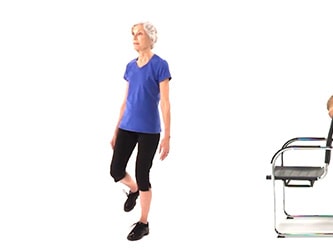Top 3 Geriatric Physical Therapy Exercises
February 4, 2024
6 min. read

Geriatric physical therapy exercises are targeted movements designed to help older adults maintain and improve their physical function, independence, and quality of life. These exercises focus on building strength, balance, mobility, and confidence, enabling seniors to perform daily activities safely and with greater ease.
Today, Sally walks into your clinic as a typical geriatric physical therapy client. In her late 70s and recently widowed, she has noticed her activity level is declining. Tasks like working in the garden or climbing stairs seem challenging. Sally heard about the benefits of geriatric physical therapy exercises for older adults on the radio and now wants to explore how they might help her regain confidence and independence. After discussing her goals, you find that she wants to garden, play with her grandchildren, and walk without fear of falling.
As a physical therapist who works almost exclusively with older adults, I see patients like Sally almost every day. Here are my top 3 geriatric physical therapy exercises that I would prescribe to Sally—and almost every older adult client—to help her make her life more enjoyable.
1. Sit-to-stand
Difficulty rising from a chair is a significant predictor for both falls and functional deficits in older adults.1 And let's face it, most of our clients spend too much time sitting. We preach to our clients all the time on the importance of movement. Geriatric physical therapy exercises often start with simple movements that build core strength and mobility.
This exercise—the "sit-to-stand"—helps strengthen muscles needed for basic movements. Even if your patient already is a sit-to-stand rockstar, you can still get creative with this basic exercise to challenge your most high-level clients.
Start by having your client sit in a basic armchair. Ask them to fold their arms across their chest and rise from the chair. If they can do it, great! Have them do it 5 more times. Ask them to gauge the degree of difficulty from 0 (easy) to 10 (impossible). If they rate it a 6-8—BOOM! There's your exercise prescription.
Exercise modifications
If this exercise is too easy for your client, consider adding reps, lowering the seat height, instructing them to close their eyes, holding weight, adding resistance bands, or performing on a single leg to challenge them further. The sit-to-stand is a great foundational exercise in geriatric physical therapy exercises that can be scaled as clients improve.
If they cannot get up without using their hands, coach them to use the least amount of assistance to successfully perform the task. Then increase the difficulty in future sessions. Don't forget to vary the context to help them meet their goal.
2. Floor transfer
Too often I hear a story like Sally's, where a patient has had to stop playing with their grandkids or working in the garden because it has become too difficult to get up from the ground. However, progressive resistance exercise has been shown to improve physical function in older adults.2 So, with a little practice and some coaching from a physical therapist, they can get that ability back!
During your assessment, ask your client to kneel on the ground. Place a sturdy treatment table or chair nearby for assistance. Have your client place their stronger foot forward and slowly lower their opposite knee to the ground. Then, ask them to rise from the ground into a standing position using their forward leg as the power leg. Geriatric physical therapy exercises like this one can improve the ability to rise from the floor, enhancing independence.
Exercise modifications
Work with your client where they are and tailor this movement to their current ability. Examples of modifications for the floor transfer include using a chair for stability, progressing from one hand support to no hand support, and adding light resistance to engage their muscles further. This exercise can be adjusted based on strength and balance levels.
3. Single leg balance
I know what you're thinking, "C'mon, single leg balance? Cant you get a little more creative than that?" But let's face it, older adults are at a higher risk for falling and that risk increases as their balance deteriorates, especially balance confidence.3 A simple yet effective geriatric physical therapy exercise to address balance confidence is the single leg stance.
Have your client stand in an open area with plenty of space. Guard them as needed and allow them to experience slight balance challenges as they practice. This exercise can help strengthen balance, an essential component of geriatric physical therapy exercises.
Exercise modifications
As noted above, vary the environment, surface, lighting, or ambient noise to provide a sufficient challenge for your client and to make it meaningful for their goals. Consider adding head turns, head turns with gaze stabilization, eyes closed, or external perturbations to maximize the degree of difficulty. Adding in a dual task, such as holding a cup of water or performing a cognitive task, can also increase the difficulty. Finally, you can incorporate an upper or lower extremity reach to challenge balance further.
Benefits of geriatric physical therapy exercises
Geriatric physical therapy exercises offer a range of benefits that can significantly improve quality of life for older adults. Here are some key advantages:
Enhanced mobility: By practicing targeted geriatric physical therapy exercises, seniors can increase their range of motion and strength, helping them to move more freely and with less discomfort.
Improved balance and fall prevention: Exercises that target balance and coordination help reduce the risk of falls, a common concern among older adults.
Increased independence: With the ability to complete daily tasks more comfortably, older adults can maintain their independence and continue participating in activities they enjoy.
Boosted confidence: As clients see progress in their physical abilities, they often feel more confident in navigating their environment and engaging in physical activities.
Building confidence and independence in older adults
By incorporating these three geriatric physical therapy exercises into your practice, you can help your clients regain strength, balance, and independence, making everyday activities feel more achievable. These exercises can empower older adults to pursue the activities they love and live with greater confidence.
References
Zhang F, Ferrucci L, Culham E, Metter EJ, Guralnik J, Deshpande N. Performance on five times sit-to-stand task as a predictor of subsequent falls and disability in older persons. J Aging Health. 2013 Apr;25(3):478-92. doi: 10.1177/0898264313475813. Epub 2013 Feb 13. PubMed PMID: 23407343.
Liu CJ, Latham NK. Progressive resistance strength training for improving physical function in older adults. Cochrane Database Syst Rev. 2009 Jul 8;(3):CD002759. doi: 10.1002/14651858.CD002759.pub2. Review. PubMed PMID: 19588334; PubMed Central PMCID: PMC4324332.
Landers MR, Oscar S, Sasaoka J, Vaughn K. Balance Confidence and Fear of Falling Avoidance Behavior Are Most Predictive of Falling in Older Adults: Prospective Analysis. Phys Ther. 2015 Aug 20. [Epub ahead of print] PubMed PMID: 26294679






